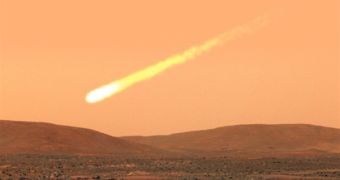With giant asteroids passing uncomfortably close to Earth and slightly smaller ones crashing near populated areas, doomsday asteroid scenarios are once again fashionable.
The fact is, while giant asteroids do occasionally hit Earth and do occasionally cause massive damage, these "occasions" are millions of years apart.
Still, we may be getting first-hand experience of what it's like for a giant space rock, an ice rock in this case, to hit a rocky planet as it seems a comet is on a collision course with Mars.
A newly discovered comet C/2013 A1 (Siding Spring) may be headed straight towards our neighboring planet and could hit on October 19 next year.
Astronomers are still trying to calculate its precise trajectory, but the current estimates say that the comet will come dangerously close to the planet, perhaps close enough for it to crash.
The earliest estimates put it on a collision course, but newer numbers indicate that the comet will come very close to the planet, but still far enough for it to pass by unfazed, 109,200 km, 67,853 miles.
However, astronomers have only been observing the comet for 74 days, so there is too little data for a very accurate estimate. Even the current estimates though, the margin of error does allow for a collision trajectory, though it's improbable.
If the comet does hit, it will be a spectacle to remember. The comet is some 50 km, 31 miles wide and it's hurtling towards Mars at an incredible speed, 56 km/s, that's 180,000 km/h or 111,846 mph thanks to its retrograde orbit, Mars and the comet are headed towards each other.
If an impact does occur, it will be massive, experts estimate a crater of 500 km, 310 miles across and 2 km, 1.24 miles deep and the energy released will be the equivalent 2x10^10 megatons.
Even if, disappointingly, there's no collision, astronomers hope that the comet will pass close enough for one of the Mars orbiters to capture some detailed photos of it.

 14 DAY TRIAL //
14 DAY TRIAL //